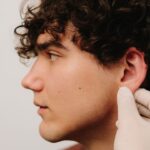Before and After Facial Reconstruction
performed by Dr. Baker in Washington, DC.

Tissue expansion is ideal for scalp repair because the stretched skin on the scalp retains normal hair growth. Most other body tissue does not grow hair to the same degree.

Following tissue expansion, the repaired scalp restores a more natural appearance.

With flap surgery, tissue, sometimes including underlying fat and muscle, is taken from the back and tunneled to the front of the chest wall to support the reconstructed breast.

The transported tissue forms a flap to cover a breast implant, or it may provide enough bulk to form the breast mound without an implant.

In a typical syndactyly, two fingers are fused together. The surgeon often uses zig-zag incisions to separate the fingers, creating triangular skin flaps.

We bring back, refashion and restore to wholeness the features that nature gave but chance destroyed, not that they may be an advantage to the living soul, not as a mean artifice but as an alleviation of illness, not as becomes charlatans but as becomes good physicians and followers of the great Hippocrates. For though the original beauty is indeed restored . . . the end for which the physician is working is that the features should fulfill their offices according to nature’s decree.
—Gaspare Tagliacozzi, 1597

It’s estimated that more than one million reconstructive procedures are performed by plastic surgeons every year. Reconstructive surgery helps patients of all ages and types – whether it’s a child with a birth defect, a young adult injured in an accident, or an older adult with a problem caused by aging.
The goals of reconstructive surgery differ from those of cosmetic surgery. Reconstructive surgery is performed on abnormal structures of the body, caused by birth defects, developmental abnormalities, trauma or injury, infection, tumors, or disease. It is generally performed to improve function, but may also be done to approximate a normal appearance.
Cosmetic surgery is performed to reshape normal structures of the body to improve the patient’s appearance and self-esteem.
Although no amount of surgery can achieve perfection, modern treatment options allow plastic surgeons to achieve improvements in form and function that were thought to be impossible 10 years ago.
Patients may be divided into two basic categories: those who have congenital deformities, otherwise known as birth anomalies, and those with developmental deformities, acquired as a result of accident, infection, disease, or aging.
Some common examples of congenital abnormalities are birthmarks; cleft-lip and palate deformities; hand deformities such as syndactyly (webbed fingers), or extra or absent fingers; and abnormal breast development.
Burn wounds, lacerations, growths, and aging problems are considered acquired deformities. In some cases, patients may find that a procedure commonly thought to be aesthetic in nature may be performed to achieve a reconstructive goal. For example, some older adults with redundant or drooping eyelid skin blocking their field of vision might have eyelid surgery. Or an adult whose face has an asymmetrical look because of paralysis might have a balancing facelift. Although appearance is enhanced, the main goal of the surgery is to restore function.
Large, sagging breasts are one example of a deformity that develops as a result of genetics, hormonal changes, or disease. Breast reduction, or reduction mammaplasty, is the reconstructive procedure designed to give a woman smaller, more comfortable breasts in proportion with the rest of her body.
In another case, a young child might have reconstructive otoplasty (outer-ear surgery) to correct overly-large or deformed ears. Usually, health insurance policies will consider the cost of reconstructive surgery a covered expense. Check with your carrier to make sure you are covered and to see if there are any limitations on the type of surgery you are planning. Work with your doctor to get pre-authorization from the insurer for the procedure.
Washington has laws in place to protect patients seeking cosmetic procedures, so make sure to do your research before selecting a surgeon.
When reconstructive surgery is performed by a qualified plastic surgeon in Washington, complications are infrequent and usually minor. However, individuals vary greatly in their anatomy and healing ability and the outcome is never completely predictable.
As with any surgery, complications can occur. These may include infection; excessive bleeding, such as hematomas (pooling of blood beneath the skin); significant bruising and wound-healing difficulties; and problems related to anesthesia and surgery.
There are a number of factors that may increase the risk of complications in healing. In general, a patient is considered to be a higher risk if he or she is a smoker; has a connective-tissue disease; has areas of damaged skin from radiation therapy; has decreased circulation to the surgical area; has HIV or an impaired immune system; or has poor nutrition. If you regularly take aspirin or some other medication that affects blood clotting, it’s likely that you’ll be asked to stop a week or two before surgery.
performed by Dr. Baker in Washington, DC.
In evaluating your condition in Washington, a plastic surgeon will be guided by a set of rules known as the reconstructive ladder. The least-complex types of treatments, such as simple wound closure, are at the lower part of the ladder. Any highly complex procedure-like microsurgery to reattach severed limbs would occupy one of the ladder’s highest rungs. A plastic surgeon will almost always begin at the bottom of the reconstructive ladder in deciding how to approach a patient’s treatment, favoring the most direct, least-complex way of achieving the desired result.
The size, nature, and extent of the injury or deformity will determine what treatment option is chosen and how quickly the surgery will be performed. Reconstructive surgery frequently demands complex planning and may require a number of procedures done in stages.
Because it’s not always possible to predict how growth will affect the outcome, a growing child may have to plan for regular follow-up visits on a long-term basis to allow additional surgery as the child matures.
Everyone heals at different rate-and plastic surgeons cannot pinpoint an exact “back-to-normal” date following surgery. They can, however, give you a general idea of when you can expect to notice improvement.

In deciding how to treat a wound, a plastic surgeon must carefully assess its size, severity, and features: Is skin missing? Have nerves or muscles been damaged? Has skeletal support been affected?
As you and your plastic surgeon form your surgical plan, it’s important to have a clear understanding of what will happen during the procedure. Asking questions is key to making an informed decision.
Direct closure is usually performed on skin-surface wounds that have straight edges, such as a simple cut. Maximum attention is given to the aesthetic result, taking extra care to minimize noticeable stitch marks.
A wound that is wide and difficult or impossible to close directly may be treated with a skin graft. A skin graft is basically a patch of healthy skin that is taken from one area of the body, called the “donor site,” and used to cover another area where the skin is missing or damaged.
There are three basic types of skin grafts.
A split-thickness skin graft, commonly used to treat burn wounds, uses only the layers of skin closest to the surface. When possible, your plastic surgeon will choose a less conspicuous donor site. Location will be determined in part by the size and color of the skin patch needed. The skin will grow back at the donor site, however, it may be a bit lighter in color.
A full-thickness skin graft might be used to treat a burn wound that is deep and large or to cover jointed areas where maximum skin elasticity and movement are needed. As its name implies, the surgeon lifts a full-thickness (all layers) section of skin from the donor site. A thin line scar usually results from a direct wound closure at the donor site.
A composite graft is used when the wound to be covered needs more underlying support, as with skin cancer on the nose. A composite graft requires lifting all the layers of skin, fat, and sometimes the underlying cartilage from the donor site. A straight-line scar will remain at the site where the graft was taken. It will fade with time.
Tissue expansion is a procedure that enables the body to “grow” extra skin by stretching adjacent tissue. A balloon-like device called an expander is inserted under the skin near the area to be repaired and then gradually filled with salt water over time, causing the skin to stretch and grow. The time involved in tissue expansion depends on the individual case and the size of the area to be repaired.
The advantages of tissue expansion are many-it offers a near-perfect match of skin color, sensation, and texture; the risk of tissue loss is decreased because the skin remains connected to its original blood and nerve supply; and scars are less apparent than those in flaps or grafts. The expander temporarily creates what can be an unsightly bulge, making this option undesirable for some patients.

Though success will largely depend on the extent of a patient’s injury, flap surgery and microsurgery have vastly improved a plastic surgeon’s ability to help a severely injured or disfigured patient. Using advanced techniques that often take many hours and may require the use of an operating microscope, plastic surgeons can now replant amputated fingers or transplant large sections of tissue, muscle, or bone from one area of the body to another with the original blood supply intact.
A flap is a section of living tissue that carries its own blood supply and is moved from one area of the body to another. Flap surgery can restore form and function to areas of the body that have lost skin, fat, muscle movement, and/or skeletal support.
A local flap uses a piece of skin and underlying tissue that lies adjacent to the wound. The flap remains attached at one end so that it continues to be nourished by its original blood supply, and is repositioned over the wounded area.
A regional flap uses a section of tissue that is attached by a specific blood vessel. When the flap is lifted, it needs only a very narrow attachment to the original site to receive its nourishing blood supply from the tethered artery and vein.
A musculocutaneous flap, also called a muscle and skin flap, is used when the area to be covered needs more bulk and a more robust blood supply. Musculocutaneous flaps are often used in breast reconstruction to rebuild a breast after mastectomy. This type of flap remains “tethered” to its original blood supply.
In a bone/soft tissue flap, bone, along with the overlying skin, is transferred to the wounded area, carrying its own blood supply.
A microvascular free flap is a section of tissue and skin that is completely detached from its original site and reattached to its new site by hooking up all the tiny blood vessels.
You did a fabulous job, and we thank you from the bottom of our hearts!“Dr. Baker, We are sincerely grateful for the beautiful surgery you performed on our daughter. I was afraid, but those fears were unfounded. You made us feel at ease. You were great with our daughter and her anxieties. You did a fabulous job, and we thank you from the bottom of our hearts! She’s like a new person and it can only get better. Once again, our experience with you has been wonderful. Thanks again for everything!”
In addition to correcting cuts and other surface wounds, plastic surgeons also regularly treat both cancerous and non-cancerous growths and problems with the supporting structures beneath the skin.
Tumors, both cancerous and benign, vary widely in type, severity, and recurrence. The removal method chosen will depend largely on the type of growth, what stage it’s in, and its location on the body.
Skin cancers and growths are usually removed by excision and closure, in which the growth is simply removed completely with a scalpel, leaving a small thin scar. If the cancer is large or spreading, major surgery may be necessary, using flaps to reconstruct the affected area.

The cost of a general reconstruction will depend on several factors. The price can be affected by body type, type of technique performed, surgical complications, and even allergies. Find out more by scheduling a consultation.
Schedule your consultation for general reconstruction in Washington – contact Dr. Baker and set up your appointment. During your appointment, you will be able to ask questions and bring up any concerns you may have about the procedure. Contact us today to get the look you’ve always wanted!
The millennial generation continues to embrace a diversity of beauty ideals as they age, so ... What Is Gluteal Augmentation?
Gluteal augmentation, or a buttock lift, is a surgical procedure to remove ... Fat grafting has become a natural and long-lasting solution for restoring facial volume and enhancing ...


As Featured In